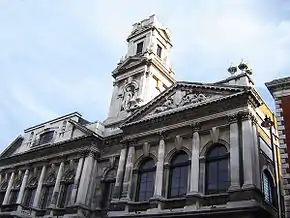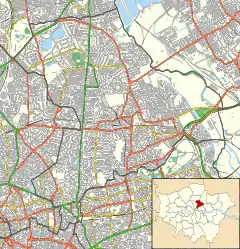Shoreditch Town Hall
Shoreditch Town Hall is a municipal building in Shoreditch, London. It is a Grade II listed building.[1]
| Shoreditch Town Hall | |
|---|---|
 Shoreditch Town Hall | |
| Location | Old Street, Shoreditch |
| Coordinates | 51.5270°N 0.0791°W |
| Built | 1866 |
| Architect | Caesar Augustus Long |
| Architectural style(s) | Italianate style |
Listed Building – Grade II | |
| Designated | 4 February 1975 |
| Reference no. | 1235232 |
 Shown in Hackney | |
History
In the mid-20th century, the vestry board decided to procure a vestry hall for the Parish of St. Leonard's; the site they selected had been occupied by some old almshouses known as "Fuller's Hospital".[2][3]
The foundation stone for the new building was laid by the Chairman of the Metropolitan Board of Works, John Thwaite, in 1865.[2] The new building, the eastern section of the current complex, was designed by Caesar Augustus Long in the Italianate style, built by John Perry of Stratford and completed in 1866.[1] The design involved a symmetrical main frontage with five bays facing onto Old Street; the central section featured a tetrastyle porch with Ionic order columns on the ground floor; there were windows interspersed with Corinthian order columns and pilasters on the first floor and a large pediment above.[1] At the time it was described as "the grandest vestry hall in London".[2] The building was embellished with symbolic statuary alluding to the borough motto, "More Light, More Power", which refer to the council's aim of generating its own electricity to power local industry.[4]
On 12 November 1888 the inquest into the death of Mary Jane Kelly, the last victim of the Whitechapel murders, was held in the building.[5]
Following the creation of the Metropolitan Borough of Shoreditch in 1899, the building was extended westwards by adding a tower and an extra three bays to the five bays that already existed.[1] The foundation stone for the extension was laid by the mayoress, Mrs Sarah Ellen Kershaw, on 9 September 1901.[6][7] The design by William Hunt created a monumental structure which was completed in 1902.[1] Internally, the principal rooms were the council chamber and mayor's parlour at the rear of the building on the ground floor and a large assembly hall in the east part of the building on the first floor.[8][9] After a major fire in the assembly hall, that part of the building was rebuilt to the designs of Alfred Cross in 1904.[1] An additional wing to the south of the main building was added in 1938.[8]
The building ceased to be the local seat of government after the formation of the London Borough of Hackney in 1965.[10] It was subsequently used as a venue for boxing and other events and in 1969 Ulric Regis died from brain injuries soon after being outpointed by Joe Bugner at the town hall.[11] In the 1990s the assembly hall served as a night club featuring trance music hosted by the Whirl-Y-Gig dance club.[2]
After a period of neglect, it passed into the ownership of the newly formed Shoreditch Town Hall Trust in 1997.[2] Following an extensive restoration programme, the building reopened as an events venue in 2004[2] and, after a further programme of works, it re-opened as an arts centre in 2012.[12]
References
- Historic England. "Shoreditch Town Hall (1235232)". National Heritage List for England. Retrieved 3 May 2020.
- "Shoreditch Town Hall". Open House London. Retrieved 3 May 2020.
- "Almshouses in Shoreditch". Lost Hospitals of London. Retrieved 3 May 2020.
- R. Crosley, London's coats of arms and the stories they tell (Robert Scott, London, 1928)
- Evans, Stewart P.; Rumbelow, Donald (2006). Jack the Ripper: Scotland Yard Investigates. Stroud, Gloucestershire: Sutton Publishing. p. 175. ISBN 0-7509-4228-2.
- "Plaque: Shoreditch town hall extension". London Remembers. Retrieved 3 May 2020.
- "Sarah Ellen Kershaw". London Remembers. Retrieved 3 May 2020.
- "London's Town Halls". Historic England. p. 77. Retrieved 3 May 2020.
- "Shoreditch Town Hall". Arthur Lloyd. Retrieved 3 May 2020.
- "Local Government Act 1963". Legislation.gov.uk. Retrieved 25 April 2020.
- Giller, Norman (2012). Henry Cooper: A Hero For All Time. Biteback. ISBN 978-1849541596.
- "Shoreditch Town Hall: Design and Access / Heritage Report for Planning Permission, Listed Building Consent and Advertising Consent" (PDF). Reed Watts. 1 March 2017. Retrieved 25 April 2020.